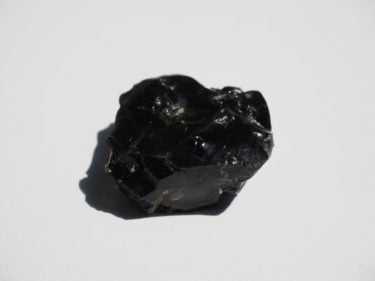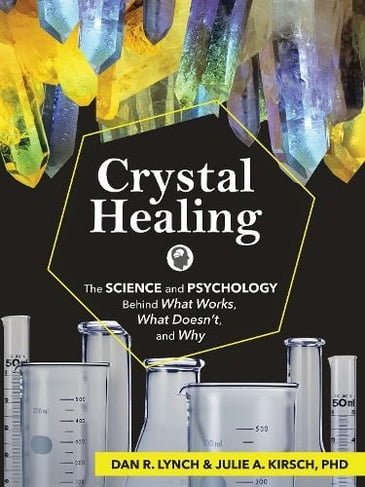Although I managed to publish a fair few scientific papers over the four decades or so of my academic career, I truly regret that there were a few studies that, despite producing interesting and publishable findings, I simply never found the time to see through to the final stage. In some cases, although I presented the results at conferences and even had fairly positive feedback from reviewers for more detailed versions that I submitted to academic journals, I never managed to get them over the line to publication purely because of pressure from other commitments.
Amongst those at the top of the list would be a pair of studies of so-called ‘crystal power’ that I carried out with a couple of very able final year students. As readers will be aware, belief in crystal power is prevalent amongst New Agers. It is believed that different crystals have different healing properties attributed to the so-called ‘subtle energy’ that they allegedly emit. The ‘subtle energies’ referred to are indeed so subtle that no one has ever actually been able to measure them scientifically. That makes them more subtle than the Higgs boson and gravitational waves – so, as you can see, they are very, very subtle indeed.
Despite the elusiveness of these subtle energies, it is claimed that crystals can be used to treat a wide range of medical complaints including degenerative diseases, infections, fertility problems, cancer, leukaemia, strokes, depression – in fact, pretty much any medical problem. Not only that, they can also apparently be used to enhance a wide range of abilities including creativity, sexual performance, telepathy, time travel, communication with spirits, and interdimensional travel, to name but a few.
The first investigation of crystal power that I carried out was in collaboration with Lynn Williams and the results were presented at the Sixth European Congress of Psychology in Rome in July 1999. Lynn had informally observed that those selling crystals at psychic fairs and similar events sometimes encourage potential buyers to “feel the energy” of the crystals for themselves, telling them that when they hold the crystal they might feel sensations such as tingling, warmth, improvements in mood, and so on. Many people do indeed report such sensations. Is this evidence that crystals really are emitting some kind of energy? Or are we witnessing nothing more than the power of suggestion at work? That was what we wanted to find out.

Without going into the full details, the basic idea behind the study was quite simple. We would get 80 volunteers to simply relax for five minutes holding the crystal, with half of them having been previously primed by getting them to read a brief Introduction to Crystals that explicitly mentioned some of the sensations that they might experience as they held the crystal. Following their brief ‘meditation’ we got all participants to indicate which, if any, of six mildly anomalous sensations they had actually experienced and how strongly they had felt them. From these data, we calculated a ‘sensations index’. We also measured their level of paranormal belief. We found that the vast majority of our volunteers reported at least one of the sensations listed and several reported experiencing some of the sensations quite strongly.
Furthermore, scores on the sensation index correlated with levels of paranormal belief, as we had expected. The group who were explicitly primed had higher scores on the sensations index in comparison to those who were not primed. Oh, and it did not make any difference to scores on the sensations index whether the volunteers were handling a genuine quartz crystal or a fake crystal made of glass, identical in appearance to a real one. In other words, our results strongly supported the idea that any sensations reported were down to the power of suggestion as opposed to any ‘subtle energy’ being emitted by the real crystal.
For our follow-up study, we used an improved double-blind methodology and data were collected by Hayley O’Donnell. Results of this study were presented to the British Psychological Society Centenary Annual Conference in Glasgow in March 2001. The design of the study was essentially the same as the original study with the major addition that we also assessed each of our 80 new volunteers for hypnotic susceptibility following their participation in the ‘meditation’ phase of the study. Hypnotic susceptibility is known to also be a good measure of suggestibility in the normal waking state. Once again, the vast majority of our volunteers reported at least one anomalous sensation but, for reasons that are still not entirely clear, this time scores on the sensations index were similar regardless of whether the volunteers were explicitly primed or not. Importantly, however, scores on the sensations index correlated with levels of paranormal belief but were not affected by the real vs fake status of the crystals.
Finally, as expected, scores on the sensations index correlated with scores on the measure of hypnotic susceptibility. Once again, our results indicated that no subtle energy was emitted from the real crystal and strongly supported the idea that the sensations reported were entirely due to the power of suggestion.
Why do I regret not getting around to publishing these studies in a peer-reviewed journal so much? Because over the years, I have had to field questions from many journalists on the topic of crystal healing whenever, for whatever reason, this becomes a relatively hot topic in the news. For example, the media appears to have a fixation on the huge number of celebrities that buy into the idea – including Adele, the Beckhams (Victoria is “a very spiritual person”), Katy Perry, Naomi Campbell, and Andy Warhol.
More recently, much negative coverage of the crystal industry has arisen, leading Eva Wiseman to ask, “Are crystals the new blood diamonds?”. In her words:
“Much like diamonds, crystal mining is an industry buried in conflict. There are issues around sustainability: crystals are a non-renewable resource. There are issues around labour: most jobs are low paid, unsafe, and sometimes performed by underage workers. And there is an issue around accountability: the industry is unregulated, allowing exploitation to go unchecked.”
The reason that I have fielded so many questions from journalists and broadcasters over the years is simply because they cannot find any other empirical work on the psychology of belief in crystal power and so are forced to rely on reports of a pair of studies carried out over two decades ago, the results of which have only ever been formally presented at conferences. This is perhaps surprising given that the crystal industry is estimated to be worth billions of dollars worldwide and, as stated, is mired in controversy on various fronts. It appears that the alleged healing properties of crystals are seen by the wider scientific community to be so ludicrous that none of them, as far as I can see, have ever been put to the empirical test. In the interests of consumer protection, I would say that is unfortunate.

Reading Crystal Healing: The Science and Psychology Behind What Works, What Doesn’t, and Why by Dan R. Lynch and Julie A. Kirsch would go a long way to correcting many of the myths relating to the topic as well as increasing awareness of the murkier side of various aspects of the crystal industry. This husband-and-wife duo really are the dream team for authoring a book such as this. He has the expertise in geology, having already written over a dozen books on rocks and minerals. She has the relevant expertise in health psychology. Between them, they have produced an accessible guide that covers all aspects of this fascinating subject. The book is beautifully illustrated throughout and very reasonably priced.
I hope this book sells well so that as many people as possible can benefit from the gems of wisdom it contains (pun totally intended). But I fear it may not. The kind of person who might consider buying a book on crystal healing is much more likely to be a victim of uncritical New Age thinking than a scientifically minded searcher after truth. The authors and publishers are clearly aware of this as there is little on the front or back cover to indicate that this book is rightly sceptical of the overblown claims made in the name of crystal healing. Their approach is pretty obvious, however, as soon as one begins to read but potential sceptical readers may never get that far. The more woo-minded reader may well get that far but no further as they would probably prefer the usual collection of unsubstantiated claims to be found in most books on the subject. To my mind, the ideal reader of this book would be an older child or younger adult who is just starting to develop an interest in crystals but whose mind has not yet been poisoned by exposure to too much woo. Prebunking is the order of the day. But it would also make a valuable addition to any sceptic’s bookshelf, so please consider getting a copy.
Inevitably, I have a couple of minor quibbles. For example, I would take issue with some of the points made regarding the nature of science and pseudoscience. Also, it looks like the authors relied on descriptions of our own studies of crystal power in secondary sources. In particular, our fakes were not “cheap plastic crystals” as had been previously wrongly reported in at least one newspaper report – they were expertly made glass fakes that virtually everyone would have struggled to distinguish from the real thing. But I am happy to say that the positive features of this book vastly outweigh any minor negative aspects.
Crystal Healing: The Science and Psychology Behind What Works, What Doesn’t, and Why. By Dan R. Lynch & Julie A. Kirsch, PhD. Adventure Publications: Cambridge, MN, 2021. ISBN: 978-1-59193-917-7. Paperback, £13.66 (Publication date: 22 April 2021).



